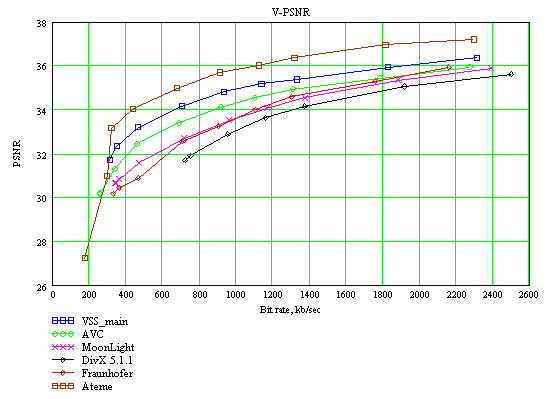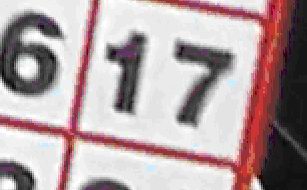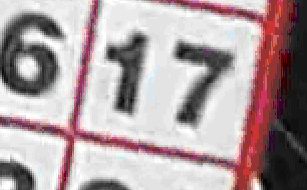| RUSSIAN VERSION HERE! |
First Annual MSU H.264/MPEG-4 AVC
Video Codecs Comparison
For professional users and codec authors
MSU Graphics & Media Lab (Video Group)Also see Selected Comments for First Annual MPEG-4 AVC/H.264 Video Codecs Comparison!
Project head: Dr. Dmitriy Vatolin
Testing, charts, analysis: Dmitriy Kulikov, Alexander Parshin
Translating: Daria Kalinkina
Verification: Stanislav Soldatov
About comparison
We would like to thank Moonlight Cordless LTD, Fraunhofer Institute for Integrated Circuits IIS and Ateme for kindly providing us their codecs for this test.
Tested codecs:
- Mpegable AVC Codec
- Moonlight H.264 Video Codec
- MainConcept H.264 Codec
- Fraunhofer IIS Codec
- Ateme MPEG-4 AVC / H.264 Codec
- Videosoft H.264 Codec
- DivX Pro 5.1.1 Codec (NOT 264! Used for comparison with H.264 codecs as well tuned codec from previous generation MPEG-4 ASP)
Current plans:
- Codec speed comparison.
- Codec compatibility comparison.
- Adding more H.264 codecs to the comparison.
Main goals
The main idea is to compare the results provided by the new codecs when they are used by an ordinary user for home video compression. As a rule, such users prefer simple and popular programs to play DVD movies or digitize signal from tuner. Also they rarely change default codec's settings. We understand that it is very hard to create codecs that would work well on different sequences using the same settings, but this situation is rather common.
Taking the peculiarities of H.264 standard into consideration (such as long time of coding when all possibilities are used) we are going to use 2 presets: "tuned" and "fast". First one is used to get maximum quality, second one is used to ensure fast processing. These presets will be provided by the codecs developers. Both time and quality will be measured. This will allow codecs to show their possibilities in terms of quality and us to compare speed in a more correct way.
Main parts of the comparison:
- Comparison in Y-PSNR, U-PSNR and V-PSNR metrics.
- Per frame comparison.
- Bit rate handling (does your movie fit on the CD?).
- Visual comparison.
- Informal codecs comparison.
Comparison with PSNR metric
PSNR - is a metric used to compare 2 pictures: the more per pixel difference between the pictures is the less is PSNR value. We use the average value of the per frame PSNR metric to compare two sequences. So the higher is the codec's line on the graph the better is the quality of compression performed by this codec.
Y-PSNR is the difference in brightness component, U-PSNR and V-PSNR are the differences in hue components.

On this picture V-PSNR values are shown. The higher the line is the better is
the quality.
Visual codec comparison
In most cases the PSNR value is in accordance with the compression quality. But sometimes this metric does not reflect presence of some important visual artefacts. For example, we can't estimate the quality of the blocking artefacts compensation performed by some codec using only PSNR metric. Also in some cases it is difficult to say whether 2 dB difference is significant or not.
That is why we use visual comparison of some frames in addition to the PSNR images. This won`t help us to understand the whole situation, but will allow to demonstrate some interesting features of the codec (e.g. block artifacts compensation).

Ateme H.264

Divx 5.1.1
These pictures present the same frame compressed by two different codecs
with the same bitrate. One can see that Ateme H.264 codec provides a
better compensation of the blocking artifacts.
Content of HTML version
Download
- First Annual MSU H.264/MPEG-4 AVC Video Codecs Comparison - PDF (3.69 Mb)
- First Annual MSU H.264/MPEG-4 AVC Video Codecs Comparison - ZIP (3.2 Mb)
If you are interested in your codecs' testing or tuning, please write to us at

| E-mail: |  |
MSU video codecs comparisons resources:
- Introduction to Video Codecs Comparison
- Lossless Video Codecs Comparison 2004 (October 2004)
- MPEG-4 SP/ASP Video Codecs Comparison (March 2005)
- JPEG 2000 Image Codecs Comparison (September 2005)
- First Annual MPEG-4 AVC/ H.264 Video Codecs Comparison (January 2005)
- Second Annual MPEG-4 AVC/H.264 Video Codec Comparison (December 2005)
- Subjective Comparison of Modern Video Codecs (February 2006)
- MPEG-2 Video Decoders Comparison (May 2006)
- WMP and JPEG2000 Comparison (October 2006)
- Third Annual MPEG-4 AVC/H.264 Comparison (December 2006) (All versions for free!)
- Lossless Video Codecs Comparison 2007 (March 2007)
- Fourth Annual MPEG-4 AVC/H.264 Comparison (December 2007) (All versions for free!)
- Options Analysis of MPEG-4 AVC/H.264 Codec x264 (December 2008)
- Fifth MPEG-4 AVC/H.264 Comparison (May 2009) (All versions for free!)
- Sixth MPEG-4 AVC/H.264 Comparison (May 2010)
- Seventh MPEG-4 AVC/H.264 Comparison (May 2011)
- Eighth MPEG-4 AVC/H.264 Comparison (May 2012)
- Ninth MPEG-4 AVC/H.264 Comparison (Dec 2013)
- Tenth Video Codec Comparison (HEVC) (Oct 2015)
- Eleventh Video Codec Comparison (HEVC) (Aug 2016)
- Twelfth Video Codec Comparison (HEVC) (Aug 2017)
- Thirteen Video Codec Comparison (HEVC) (Aug 2018)
- Fourteen Video Codec Comparison (HEVC) (Sept 2019)
- Cloud Encoding Servoces Comparison 2019 (Dec 2019)
- Fifteen Video Codec Comparison (HEVC) (Dec 2020)
- Sixteen Video Codec Comparison (Dec 2021)
- Seventeen Video Codecs Comparisons (Nov 2022)
- Eighteenth Video Codecs Comparisons (Apr 2025)
- Nineteenth Video Codecs Comparisons (2025)
- Codec Analysis for Companies:
Other materials
Video resources:
Server size: 8069 files, 1215Mb (Server statistics)
Project updated by
Server Team and
MSU Video Group
Project sponsored by YUVsoft Corp.
Project supported by MSU Graphics & Media Lab